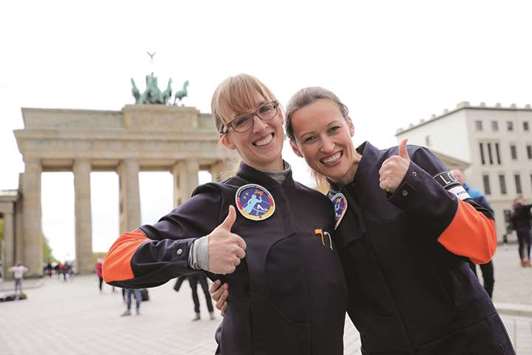Which places would you most love to visit before you die? Nicola Baumann’s list is more ambitious than most: the International Space Station, the moon, Mars. But within a few years, she is hoping to tick at least one of these off.
For this German woman, the space station orbiting about 400 kilometres above the earth is just a few steps away. She is currently training near Moscow for a potential mission in 2020.
The 32-year-old fighter pilot from Cologne is one of two women who have been chosen to undertake the training following a national search in Germany for potential female astronauts, a project dubbed “Die Astronautin” (“the female astronaut”).
The company HE Space, which is behind the project, is planning to use private financing to send the first German woman to the space station on a brief mission.
About 400 scientists, engineers and pilots applied for the programme. Baumann and a meteorologist, Insa Thiele-Eich, are the final two to have been shortlisted for the pioneering mission. So far, 11 German men have been in space, but no women.
From mid-August, the two women are scheduled to complete parabola flights, centrifuge training and other tests. The programme for the potential astronauts in Star City, near Moscow, is challenging. But this is routine in the suburb of the Russian capital. For Baumann, it is a gift: “I’m as happy as a kid at Christmas,” she told DPA.
This is where the first man in space, Yuri Gagarin, trained for his 1961 mission, as did the first woman in space, Soviet cosmonaut Valentina Tereshkova, for her 1963 mission. Prominent German astronaut Alexander Gerst, who was aboard the International Space Station (ISS) in 2014 and plans to go again in 2018, also trained here.
After Tereshkova’s mission, it would be decades before the Soviets sent the second woman into space. In total, only four Russian women have travelled to the cosmos. As Russian cosmonaut Pavel Vinogradov has told the Russian news agency NSN, “Going to space is physically hard work, even for very strong men. Of course, it is harder for women.”
Other Russian space experts have complained that there are too few female applicants. Vinogradov, who previously commanded the ISS, has suggested another reason: “This is a difficult profession that demands years away from your family. Not every woman would do this.”
US space agency NASA did not allow women into its astronaut training programme until the 1970s. In 1983, Sally Ride became the first American woman in space, and more than 40 American women have followed her lead. In total, about 60 women from various countries have travelled to space.
American astronaut Peggy Whitson, currently aboard the ISS, has spent more days in space, in total, than any other American, having clocked up more than 600.
The European Space Agency (ESA), in contrast, has sent relatively few women to space. The ESA’s last female astronaut aboard the ISS was Italy’s Samantha Cristoforetti in 2014. Before her, France’s Claudie Haignere served on the orbiting outpost in 2001. Britain has only sent one female astronaut to space, Helen Sharman, who served on the Mir space station in 1991.
NASA has been striving for years for equal representation of men and women in its astronaut training programme, Baumann says. “The push for women to study the sciences and work in scientific fields is much more present in the US than in Germany.”
The ESA has intermittently sought female astronauts for missions on the ISS, most recently in 2008. “Many more women could have applied. Many do not dare. There is a lot of unused potential,” says Baumann, who served for years as a fighter pilot in the German military.
It is always easier to follow a trail that someone else has blazed, Baumann adds. That is what inspired the German project. Baumann, who is only 1.6 meters tall, insists that you do not have to be Superman to accomplish a difficult mission. “Young women are supposed to think, ‘If she can do this, I can.’” -DPA

Insa Thiele-Eich, left, and Nicola Baumann are the final two candidates left in the search for Germany’s first female astronaut. The project, u201cDie Astronautin,u201d is being financed by the company HE Space.
